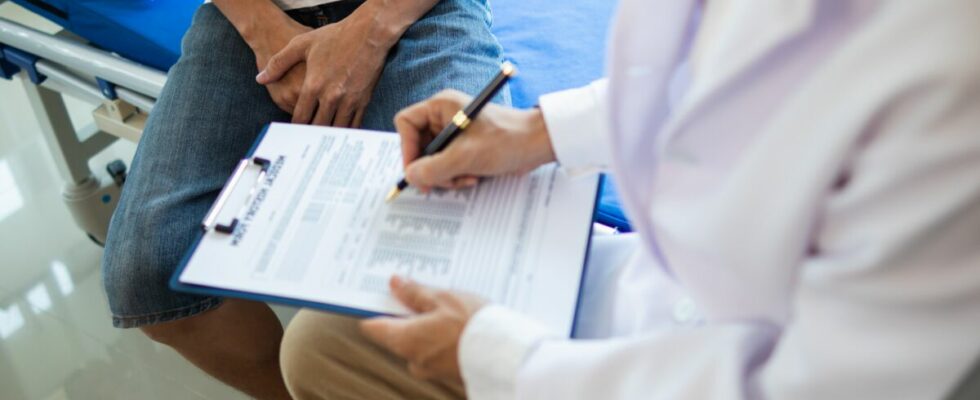Each testicle has its own epididymis. It is a canal wrapped around the testicle, in which sperm mature. In case of inflammation caused by an infection of the epididymis, the testicle may be affected. We are then in the presence of a complication of epididymitis: epididymitis orchiepididymitis. It particularly causes pain in the scrotum. Find out what orchiepididymitis is, what its symptoms are and its treatments.
1. Definition of orchiepididymitis
Orchiepididymitis is an inflammation that affects the bursae of men. It combines two inflammations. The first is the inflammation of the epididymis, this canal located on the wall of each testicle, wrapped around it, which has as an extension the vas deferens, and finally, the ejaculatory duct. It is in the epididymis that sperm are stored until they mature. Following a bacterial infection in particular, humans may be subject to inflammation of the epididymis, called epididymitis.
In the absence of medical treatment, this inflammation, due to its proximity to the testicles, can lead to inflammation of the latter. This inflammation of the testicles has the medical name of orchitis. Therefore, epididymis orchiepididymitis combines this double inflammation of the testicles and the epididymis. In other words, it results from a complication of epididymitis. In the majority of cases, only one of the two epididymis is inflamed and therefore only one of the testicles is affected. This causes permanent pain in the skin surrounding the testicles (scrotum). This pain can radiate into the lower abdomen. It may be accompanied by swelling of the testicles, redness, fever, nausea, or even difficulty urinating, depending on the MSD Manual.
2. Causes of orchiepididymitis
Several factors can lead to orchiepididymitis. Among the most frequently encountered causes, we observe a bacterial infection of the epididymis, informs EM Consulte.
- The bacterial cause of orchiepididymitis: the nature of the bacteria involved varies depending on the age group of the infected patient. Before the age of 35, orchiepididymitis is essentially the consequence of a sexually transmitted infection. In other words, risky behavior due to unprotected sexual relations. Infections are then due to Chlamydia or gonococci. From the age of 35, several types of bacteria can cause this inflammation: the bacteria causing syphilis, or tuberculosis (rarer), or the bacteria present in the fecal flora (enterococci, Escherichia coli). Risk factors have also been identified in men aged over 35, namely immunosuppression (chemotherapy treatment, anti-graft rejection treatment, AIDS), having a urinary catheter or even urological pathologies. .
- The viral cause of epididymitis: certain viruses, such as the mumps virus and Human Herpes Virus-5.
- The mycotic cause of epididymitis: microscopic fungi.
- Other causes of orchiepididymitis: benign hyperplasia of the prostate (increase in its volume), urinary reflux, stenosis (narrowing of the urethral canal) or trauma to the testicles.
3. Diagnosis and treatments of orchiepididymitis
To make a diagnosis, the doctor carries out a clinical examination and prescribes tests. These examinations are a cytobacteriological examination of urine (ECBU), a rectal examination (search for possible inflammation of the prostate), and also a screening test for STIs (sexually transmitted infections), particularly in men with sexually transmitted behavior. risk, as well as an ultrasound of the testicles (for differential diagnosis). It is essential to be diagnosed in cases of orchiepididymitis. Indeed, in the absence of medical care, complications can arise: septicemia, infertility, testicular abscess.
Treatments for orchiepididymitis depend on the cause identified. They aim on the one hand to relieve the symptoms, and on the other hand to treat the cause of the inflammation. The pain can be relieved by painkillers, non-steroidal anti-inflammatories, and ice packs on the painful area. If a bacterial infection is detected, antibiotic treatment is prescribed to eradicate it. Rest in bed is strongly recommended. Finally, it is advisable to wear a testicle jockstrap. This is an underwear that looks like briefs, but whose shape allows the testicles to be supported during movements, and therefore less pain.
Sources
- Epididymitis and epididymitis orchiepididymitis, Dr. Patrick J. Shenot, The MSD Manual – Consumer Version, August 2023
- The facts in brief. Epididymitis and Orchiepididymitis, MSD Manual – Consumer Version, January 2022
- Orchi-epididymitis, UROVar, Information site on urinary tract diseases, 2024
- Epididymitis and epididymitis of infectious origin, EM Consulte, January 25, 2021
